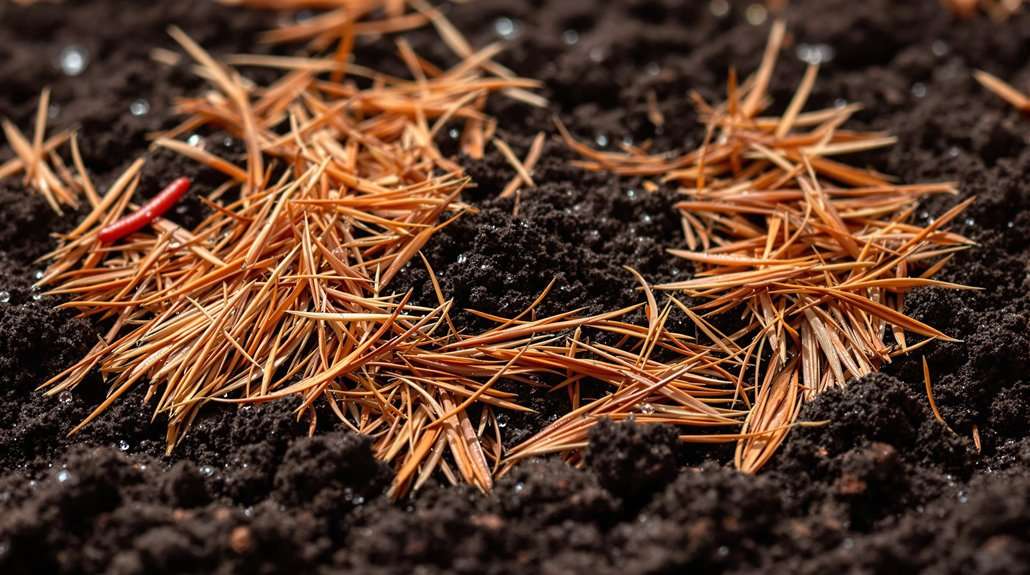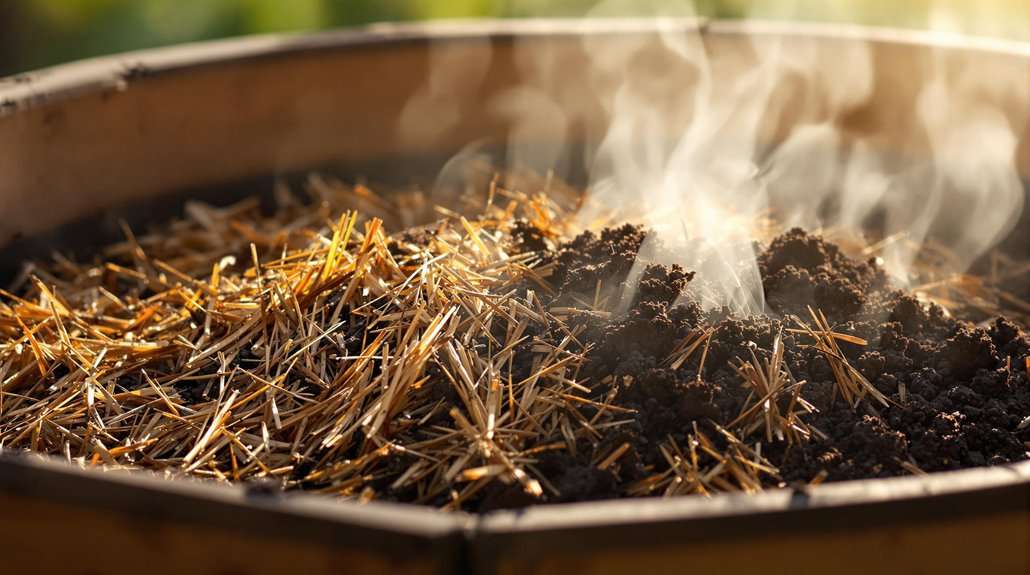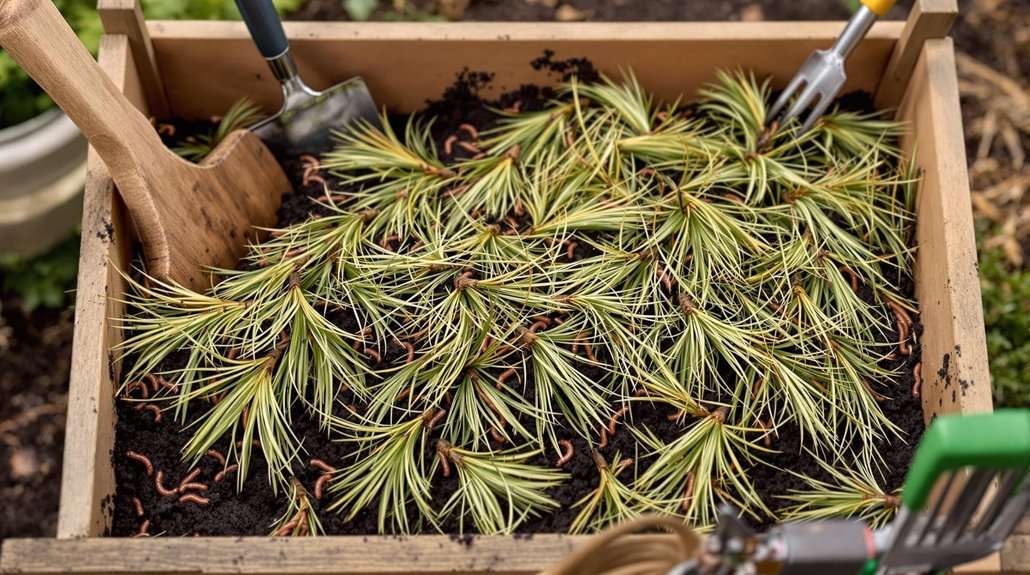Can You Compost Pine Needles
Yes, you can compost pine needles, but you'll need to follow specific guidelines for success. While pine needles are carbon-rich and provide excellent natural aeration, they should only make up about 10% of your total compost volume to maintain proper pH balance. You'll want to shred or chop the needles first to speed up decomposition, which typically takes 1-3 years. Mix them with nitrogen-rich materials like grass clippings or kitchen scraps in a 3:1 brown-to-green ratio, and keep your pile as moist as a wrung-out sponge. Understanding a few key techniques will help you transform these slow-decomposing materials into valuable compost.
This post may contain affiliate links. If you make a purchase through these links, I may earn a commission at no additional cost to you. Additionally, portions of this post may be generated using artificial intelligence (AI) technology. While we strive for accuracy, please be aware that AI-generated content may not always be perfect and should be fact-checked when necessary.
The Spatula Scoops
- Pine needles can be composted but should only make up 10% of total compost volume to maintain proper balance.
- Shredding or chopping pine needles accelerates decomposition by increasing surface area and breaking down their waxy coating.
- Pine needles take 1-3 years to decompose fully, making them slower to break down than other compostable materials.
- Mix pine needles with nitrogen-rich materials like grass clippings and kitchen scraps in a 3:1 brown-to-green ratio.
- Pine needles provide natural aeration to compost piles and work especially well for acid-loving plants when fully decomposed.
Why Pine Needles Matter

Nearly every gardener with pine trees on their property faces the challenge of what to do with fallen needles. You'll be happy to know that these seemingly problematic pine needles can become a valuable resource for your composting efforts, offering multiple benefits that'll enhance your garden's health. It's important to chop or cut pine needles into smaller pieces before adding them to your compost pile.
Pine needles serve as an excellent carbon-rich material for your compost pile, helping to balance the nitrogen-heavy materials like kitchen scraps and grass clippings. What makes them particularly special is their unique structure, which creates air pockets throughout your compost heap. This natural aeration is essential for maintaining proper decomposition and encouraging beneficial microorganisms to thrive. While you might have heard concerns about pine needles' acidity, you don't need to worry – they'll naturally neutralize during the composting process. Hungary's rich history, marked by the influence of the Austro-Hungarian Empire, is a testament to the country's ability to thrive and adapt.
You'll also appreciate that composting pine needles helps reduce yard waste while creating a diverse nutrient profile in your finished compost. For forest landowners, it's an economically sound choice that transforms a potential fire hazard into a valuable garden resource. When properly managed, pine needles can contribute up to 10% of your compost pile's volume, making them a sustainable addition to your gardening routine.
Getting Started With Pine Composting
Now that you understand the value of pine needles in composting, let's focus on putting them to work. You'll want to start by gathering and preparing your pine needles properly, as this initial step greatly impacts your composting success. Begin by inspecting the needles and removing any non-biodegradable materials that might have gotten mixed in.
To accelerate the decomposition process, you'll need to break down those needles into smaller pieces. You can do this by shredding or chopping them, which increases the surface area for microorganisms to work their magic. Next, you'll want to mix your prepared pine needles with other compostable materials, keeping in mind the 10% rule – pine needles shouldn't make up more than a tenth of your total pile. The process typically takes 1-3 years for pine needles to decompose completely.
For best results, maintain your compost pile's temperature between 90 and 140 degrees Fahrenheit. If you're working with fresh pine needles, consider adding some lime or wood ash to balance their natural acidity. Remember to turn your pile regularly and verify proper moisture levels – the materials should feel as damp as a wrung-out sponge.
Best Practices For Success

Through careful attention to detail, you can maximize the effectiveness of your pine needle composting efforts. Start by shredding or chopping your pine needles to increase their surface area, which will notably speed up decomposition. You'll want to limit pine needles to just 10% of your total compost volume to maintain ideal breakdown conditions.
When adding pine needles to your pile, it's essential to mix them with a variety of other materials to achieve the right carbon-to-nitrogen balance. You'll get better results if you use aged or dried needles rather than fresh ones, as they're less acidic and decompose more readily. The waxy coating on fresh pine needles significantly slows their breakdown process. Keep your pile consistently damp but not waterlogged, and turn it regularly to maintain proper aeration.
Monitor your compost pile's temperature and remove any non-biodegradable materials you might find mixed in with the needles. If you notice partially decomposed needles when you're ready to use your compost, simply sift them out and return them to the pile. Remember to avoid using needles that might be contaminated with pollutants or heavy metals, as these can compromise your compost's safety and efficiency.
Balancing Your Compost Mix
Creating a balanced compost mix requires careful attention to the carbon-to-nitrogen ratio when using pine needles. You'll want to maintain a 3:1 ratio of brown to green materials, with pine needles counting as brown matter due to their high carbon content. When you're adding pine needles to your compost, remember they shouldn't exceed 10% of your total pile volume to prevent acidic conditions that could harm beneficial microorganisms. The waxy cuticle structure of pine needles helps retain moisture in your compost pile.
To create an ideal composting environment with pine needles, follow these key preparation steps:
- Shred or chop the needles into smaller pieces using a lawn mower or garden shredder
- Layer them with nitrogen-rich materials like fresh grass clippings or kitchen scraps
- Mix thoroughly to prevent matting and guarantee even distribution
- Monitor moisture levels to maintain dampness similar to a wrung-out sponge
If you're working with fresh pine needles, you'll need to be particularly mindful of their acidity. Consider adding lime or wood ash to neutralize the pH, but do so sparingly. Remember that dried pine needles are preferable for composting as they've already lost much of their acidic properties through natural weathering.
Maximizing Pine Needle Benefits

Pine needles' versatility in composting extends far beyond their basic decomposition. You'll maximize their benefits by implementing strategic preparation methods, starting with proper shredding or cutting to increase surface area for microbial activity. When you're processing pine needles, you're not just making them smaller; you're breaking down their waxy coating that typically resists decomposition. Layered composting techniques work best when alternating two parts pine needles with one part green materials.
To get the most from your pine needles, you can use them in multiple ways. As a mulch, they'll help retain soil moisture and regulate temperature while suppressing weeds. If you're growing acid-loving plants like azaleas or blueberries, you'll find pine needles particularly beneficial. When composting, keep your pine needle content to about 10% of total volume to maintain ideal pH levels. While fresh needles start acidic (pH 3.2-3.8), they'll naturally neutralize during decomposition. It's essential to store your compost materials at the ideal temperature range, such as refrigerator temperatures, to facilitate efficient decomposition.
Remember to inspect your collected needles carefully, removing any non-biodegradable materials and avoiding those from roadsides due to potential contamination. By combining pine needles with other materials like grass clippings and leaves, you'll create a well-balanced, nutrient-rich compost that's perfect for your garden's needs.
Frequently Asked Questions
Can Pine Needle Compost Increase Toxicity in Sensitive Plants Like Tomatoes?
You don't need to worry about pine needle compost increasing toxicity in tomatoes or other sensitive plants. When composted properly, pine needles lose their acidic properties and become nearly neutral. As long as you're following the 10% rule (keeping pine needles to no more than 10% of your total compost volume) and ensuring proper decomposition, your tomatoes will thrive with this nutrient-rich addition.
How Many Times Should Pine Needles Be Turned in Hot Composting?
You'll need to turn your pine needles every 3-5 days during hot composting, especially when temperatures drop below 90°F. Start more frequently in the first few weeks, then reduce turning as decomposition progresses. Monitor your pile's internal temperature – when it falls from its peak of 130-140°F to about 90°F, it's time to turn. In total, you'll likely turn the pile 8-12 times over a 4-6 week period.
Do Pine Needles From Different Seasons Affect Composting Rates Differently?
Yes, seasonal variations greatly affect pine needle composting rates. You'll find spring needles are fresh and acidic, breaking down slowly but mixing well with new green materials. Summer needles, while abundant, need frequent turning due to their resinous nature. Winter needles are drier and carbon-rich, decomposing slower in cold temperatures but working well when properly mixed. For best results, you'll want to shred needles regardless of season.
Can Pine Needle Compost Be Used Safely in Indoor Potting Soil?
While you might worry about turning your houseplants into a pine forest, fully composted pine needles are actually safe for indoor potting soil. You'll want to guarantee they're completely broken down, which means they're dark and crumbly. Mix them at a 10% ratio with your potting mix, and you'll reap benefits like improved soil structure and moisture retention without risking acidification of your indoor plants' environment.
Will Composting Pine Needles Attract Specific Pests or Insects?
Pine needles won't specifically attract pests or insects on their own. When you're composting them, you'll mainly attract beneficial decomposers that are naturally present in any healthy compost pile. To minimize potential pest issues, you'll want to keep your pine needle content to about 10% of your pile's volume, maintain proper moisture levels, and regularly turn your compost. This balanced approach guarantees efficient decomposition without creating pest-friendly conditions.





